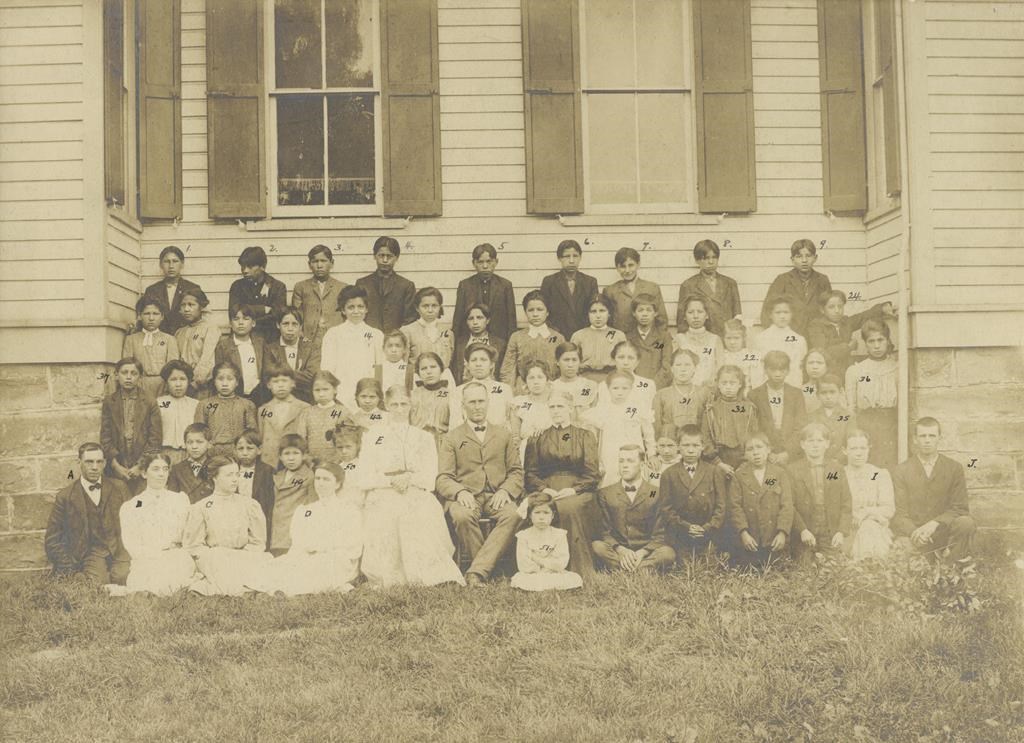U.S. team to digitize Quaker boarding school records, drawing inspiration from Canada

OTTAWA — A coalition advocating for Indigenous Peoples forced to attend boarding schools in the United States is planning to digitize 20,000 archival pages related to schools that were operated by the Quakers.
Outside of Native Nations, most people aren’t even aware these schools were an integral part of history and U.S. federal Indian policy, said Samuel Torres, the deputy CEO of the Native American Boarding School Healing Coalition.
He and his team are trying to change that, drawing inspiration — and lessons learned — from Canada’s Truth and Reconciliation Commission and the National Centre for Truth and Reconciliation.
Advertisement
The Quakers and other faith groups have in recent years either begun or increased efforts to research and atone for their roles in the boarding school system that Indigenous children in the U.S. were forced to attend. The institutions cut them off from their families, tribes and traditions, similar to residential schools in Canada.
For decades, documents related to Quaker-operated Indian boarding schools have been largely understudied, in part because they exist in remote and dispersed collections with limited access, Torres said.
The coalition, alongside Friends Historical Library of Swarthmore College and Quaker & Special Collections at Haverford College, with financial support from the National Historic Publications and Records Commission, will scan 20,000 pages of enrolment papers, photographs, financial information, correspondence and administrative records from 1852 to 1945 this fall.
After the scanning, project leaders will hold an information session with tribal communities to discuss the findings. The project will include the production of a video with shared oral histories from boarding school survivors and their families.
“Indigenous data sovereignty” will be front and centre, with survivors deciding which documents would not be appropriate for public consumption, Torres said.
Advertisement
“It’s a commitment that recognizes data — both physically and philosophically — belong to the people whom they’re about,” he said.
The approved digitized records will be made available in spring 2024 on a database called the National Indian Boarding School Digital Archive, which the coalition will launch later this year.
Torres recognizes the road to healing won’t end with its release.
Instead, it’s part of a longer process that is likely to take generations — but it’s something he found even more important to research after a First Nation in Canada called him with some troubling news a couple of years ago.
In May 2021, Tk’emlups te Secwepemc Nation in British Columbia announced that ground-penetrating radar had detected what are believed to be 215 unmarked graves at the site of the former Kamloops Indian Residential School.
Advertisement
The finding shocked millions across the country and around the world, despite residential school survivors having described such places for decades.
“We saw a paradigm shift,” said Torres, noting people in the U.S. began asking questions about what happened there, but weren’t sure where to find the answers.
“We learned from various reconciliation commissions through the world,” with the most relevant being Canada’s.
Canada, however, is also grappling with access to records and the archiving of survivors’ testimonies.
Of the thousands of former residential school students who detailed the abuses they suffered to an adjudicator tasked with determining their eligibility for compensation under the historic Indian Residential Schools Settlement Agreement, only about 30 have sought to have copies of their words archived.
Advertisement
If they’re not archived within five years, they’ll be destroyed.
The records are the product of what was known as the Independent Assessment Process, which survivors had to go through to access compensation for abuses they suffered as children.
The debate surrounding the future of these records has gained momentum since more First Nations in Canada began seeking answers about what happened to the children who died and disappeared from residential schools.
By 2014, the question of what should happen to those transcripts and supporting documents landed at the Ontario Superior Court of Justice.
On one side, the Truth and Reconciliation Commission of Canada and the National Centre for Truth and Reconciliation — the archive established to house its records — along with the federal government said they ought to be preserved. The chief adjudicator of the compensation process and 24 Catholic Church entities argued they should be destroyed.
Advertisement
The Assembly of First Nations supported the latter position.
The Ontario Superior Court of Justice ultimately ordered the records to be destroyed after giving survivors 15 years to seek copies of their own files.
But one thing neither the courts nor compensation process considered was the deaths and disappearances of children, said Kimberly Murray, who serves as an independent adviser to Ottawa on how to help Indigenous communities search for unmarked graves and retrieve records.
And, Murray said, some religious groups have yet to turn over the records in their possession.
Torres and the National Native American Boarding School Healing Coalition are keeping a close eye on the happenings here.
Advertisement
“While I think many folks here in the United States would argue that we’re even behind the status quo (compared to the) progress of the Canadian commission process, I think there are opportunities for being able to get more things right,” he said.
This report by The Canadian Press was first published Aug. 26, 2023.
— With files from Stephanie Taylor and The Associated Press
Alessia Passafiume, The Canadian Press
Advertisement